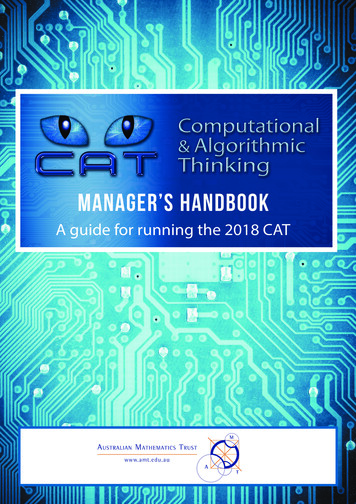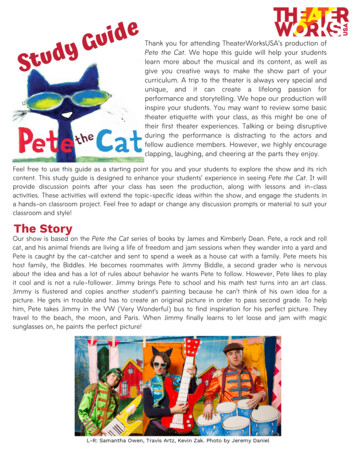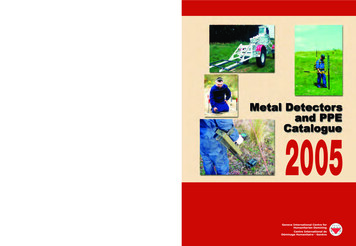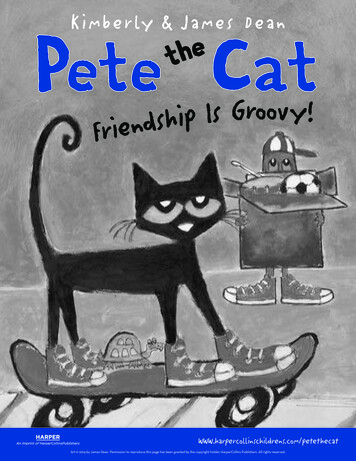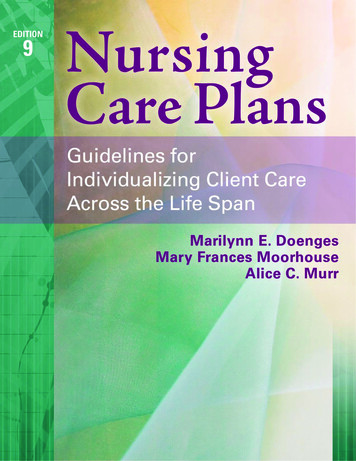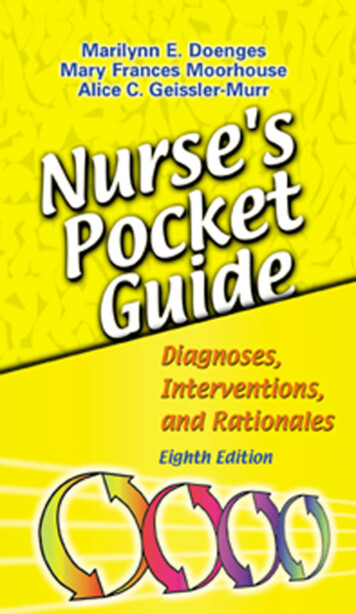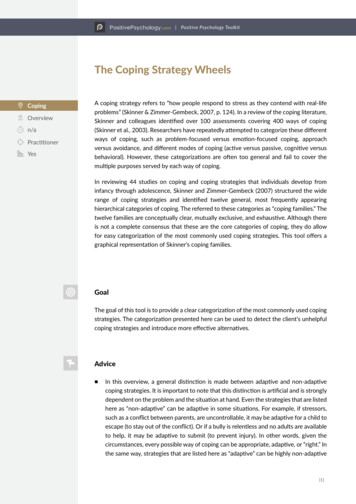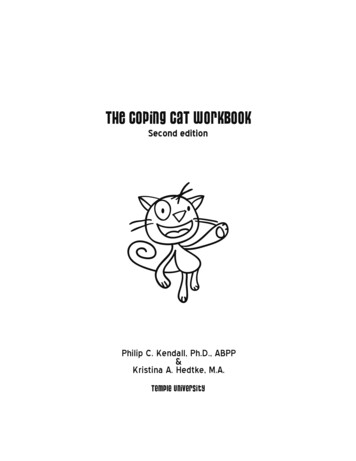
Transcription
THE COPING CAT WORKBOOKSecond editionPhilip C. Kendall, Ph.D., ABPP&Kristina A. Hedtke, M.A.Temple University1
The Coping Cat WorkbookSecond EditionCopyright 2006by Workbook PublishingISBN: 1-888805-21-8All rights reserved. None of the pages or materials may be reproduced by any means, stored in a retrievalsystem, or transmitted in any form or by any means, electronic, mechanical, photocopying, microfilming,recording, or otherwise, without the written permission from the copyright holders.Illustration and design by Robbi@robbibehr.comThis workbook benefited greatly from the input of numerous colleagues and clients. Special thanks toall trainees and professionals who have studied and worked within the Child and Adolescent AnxietyDisorders Clinic (CAADC). Also, the input of the many youth and their families who have participated inactivities within CAADC is very much appreciated.Printed in the United States of America9 8 7 6 5 4 3 2 1 info@workbookpublishing.com 2
SESSION 1: INTRODUCTIONHi! My name is Coping Cat. Along with your therapist, we’ll be workingtogether for the next several weeks. Each time we meet, we’ll be doingsome tasks together. Now, this book may look like a lot to finish, butdon’t be alarmed. You won’t be graded or tested on any of these tasks.Relax - we’re going to try to have a good time while working together.Before we get started, I want to introduce myself. I think it’s easierto work with someone when you know a little about them. I’ll start at thebeginning. I was born on September 3, 1988.I have two sisters and three brothers.When I was only six weeks old, I wasadopted by a nice family. Boy, was I scaredwhen I first went to my new home! I even hidunder the couch for awhile. It seemed likeI was afraid of everything. I guess that’show I got the name Scaredy-Cat. I still getscared sometimes, but I’ve learned how tohandle it.Now you know a little about me. Let’s findout about each other.Activities menuPersonal Facts GameWhat is your therapist’s first name?What is your therapist’s middle name?When is his/her birthday?What is his/her favorite TV show?How many sisters or brothers does he/she have?1
Now make up three of your own questions and see if you can find out the answers.1.2.3.GamesPick out a game or fun activity to play with your therapist.Introduction to feelings and thoughtsThroughout this workbook, we’ll be talking about your feelings in different situations. Sometimeswe’ll talk about situations that you enjoy and at other times we’ll talk about situations that makeyou feel nervous or scared.Let’s start off today with a situation that was fun. I want you to think of a time whenyou really enjoyed yourself. Take a minute to think. Got one? Great! Now that you’vethought of the situation, I’d like you to describe it in the space below. Tell mewhat the situation was, how you felt and what you thought.FEELING GREAT!SituationYour Thoughts2Your Feelings
Next describe a situation that happens on a typical day. Think of a time thatwas OK, not great but not bad either. Remember to say what the situationwas and what you thought and how you felt.NORMAL DAYSituationYour ThoughtsYour FeelingsLearning about S.T.I.C. tasksWe’re going to end each session with an assignment we call a S.T.I.C. task. A S.T.I.C. task issomething you can do to “Show That I Can (S.T.I.C.).” You will be learning lots of new thingsworking with your therapist and doing this workbook. We want you to take what you learn withyou and use those new skills in other situations. That’s why we came up with the idea of S.T.I.C.tasks. They’re your opportunity to practice what you’ve learned. Then at the beginning of eachsession, you can show your therapist what you have accomplished. It’s your chance to boast!Every time you do a S.T.I.C. task, you will receive 2 points or stickers that you can use to earna reward. What kinds of rewards would you like to be able to earn? On page 73 you’ll see a“Reward Menu.” This is where you can list each reward and the number of points that it costs.After sessions 4, 8, 12, and 16, you can spend your points on some of the rewards you listed inthe Reward Menu.Your S.T.I.C. Task For Next Time 1. Write an example of another time you felt really great--you weren’t upsetor worried. Remember to describe the situation you were in, what youwere thinking, and how you were feeling.Do this task on your own for next time. When you and your therapistdiscuss it next time you can earn 2 points, so be sure to remember!3
S.T.I.C. Task - Session 1Describe a time this week when you felt really great — when you weren’t upset or worried.Remember to describe the situation you were in, what you were thinking, and what youwere feeling.Do you remember what S.T.I.C. means?S.T.I.C.4
SESSION 2: RECOGNIZING FEELINGSHow did you do on the S.T.I.C. task from last time we met?(Discuss it, then record the points in the “bank” on page 72.)Activities menuWhat Feelings do People Have?This week we’ll have some fun learning about the many different feelings that people can haveand how to recognize these feelings in ourselves and others. Let’s start by listing some differentfeelings you can think of on the lines below.Good Job!How do you know when.someone’s angry?someone’s sad?someone’s happy?someone’s surprised?5
Now that you are thinking about feelings, think about this: Besides SAYING what they feel, howelse do you know what someone is feeling?Here’s a question. How do you know when someone is angry? Can you think of two ways? Writeyour answer in the spaces below.1.2.Match the Face with the FeelingMany people show their feelings by the look on their faces. Others may show their feelings bywhat they do with their bodies. First, let’s think about how people show their feelings in theirfaces. Let’s try to figure out what feeling each of the following faces is showing and write theword for the feeling below the face.6
Feelings Role Play: Can You Guess What I’m Feeling?Try and show your feelings using only your face and body. No words! You can do it! Seeif your therapist can guess what you are feeling.If I were in this situation I’d feel.Read the following stories and write in a feeling that you might have.Draw a face to show that feeling.1. Your best friend comes running up to you on theplayground. Your friend says, “Let’s go play!”What feeling would you have?2. This week you and your class did a pretty goodjob on your assignments and were very wellbehaved and the teacher decided that you couldall go on the school trip to the zoo. But on theday of the trip it is raining so the trip to the zoois cancelled.Draw a face to show that feeling.What feeling would you have?Draw a face to show that feeling.3. You are at home and your parents are outside.You are the only one in the house — you hear anoise in the other room.What feeling would you have?7
What are these people feeling?Here are some drawings of different children and adults. Take a close look and think about howeach person might be feeling. Write down one feeling for each person.8
My therapist feels worried when.Ask your therapist about a time he or she felt worried or scared. Find out how your therapisthandled the situation.Let’s look at the situation cards or fear ladder.On page 74-76, you’ll find some “situation cards.” They’re labeled “easy,” “medium,” and“challenging.” Whenever you think of a situation in which you feel only a little bit nervous ortense, write it in on one of the “easy” cards. If it would be really scary, write it in on one of the“challenging” cards. When you think of a situation in which you feel scared or worried, but it’snot too easy or not too scary, write it on one of the “medium” cards.If you want to, you can write the scary situations in the fear ladder on page 77 instead of usingthe situation cards. Your therapist can show you how.recap I’m sure you’ve got the idea now: you cantell a lot about feelings from expressionson people’s faces and from other partsof their bodies. For example, you cansometimes show your feelings in theway you stand or sit, in where you putyour hands, or how you hold your head.Your S.T.I.C. Task For Next Time On the next page, write about 2 situations that happened to you. One situationshould be a time when you felt really nervous, scared, or worried. The othersituation should be a time when you felt relaxed. It’s important to writeabout the situation as soon as you can, so you don’t forget anything. Besure to include details about what happened. Write down how you knewwhat you were feeling and the thoughts or feelings you had.9
S.T.I.C. Task - Session 2Write about two situations that happened to you this week. One situation should be a time whenyou felt really nervous, scared, or worried. The other situation should be a time when you feltrelaxed. Remember to describe the situations, what you were thinking, and what you were feeling.I was nervous, scared, or worried whenI was relaxed whenWatch someone else this week. It can be someone in your family, or a friend, or a TVcharacter. How can you tell what this person is feeling if they don’t tell you?Name of other person:Situation:The other person’s feeling:What did you see that was a clue to the other person’s feelings?10
SESSION 3: HOW DOES MY BODY REACT?Today we’re going to talk about the waysour bodies might react when we feelnervous. For example, as a cat, I show thatI’m scared when my fur stands up. WhenI’m frightened, I feel like a Scaredy Cat.Sometimes being afraid is ok - there aretimes when everyone is a little bit afraid.But, there are other times when we don’thave to be afraid. When I keep my cool,and I feel like I can cope with whatevercomes my way. I’m a Coping Cat.Activities menuHow do my family members show that they’re scared?When people are scared, they can notice that their bodies give them clues or hints that theyare scared. Think of a time when a family member or a friend of yours was scared. What wayscould their bodies tell them that they were scared? Write them in the spaces below.1.2.3.Draw a picture of a person who is feeling scared or worried.11
How do our bodies tell us we’re anxious?Look at the drawing of the human body below. Which part of your body gets a funny feelingwhen you feel nervous or worried? Draw a circle around it and describe how it feels.healungsdhearthcmane ss tiostinteleg muscles12arm muscles
Let’s answer some questions about how our body reactsSometimes there are several different reasons that could explain your feelings and how yourbody is reacting. Read the following situations and circle the number of the reason you think isthe most likely why the person in the story feels the way he/she does.Marina was very hungry, so she ate the tuna fish that had been in the fridge for several weeks. Afew hours later her stomach feels upset.Why do you think her stomach hurts?1. The tuna fish was spoiled.2. Somebody punched her.3. She’s worried about a test.Terry is about to give a book report in front of his class. He notices that he feels sweaty.Why might he feel that way?1. He ran to school earlier that morning.2. It’s a hot day outside.3. He’s nervous about speaking in front of the class.The last time Chris went to the dentist, he had to have a shot that hurt a little bit. Six monthslater he’s in the dentist’s waiting room again. When the dentist calls him to come and sit in thedentist’s chair, Chris feels his heart beating really fast.What could have caused his heart to beat so fast?1. He swam in a race right before he went to the dentist.2. He drank too much soda pop.3. He was worried about what might happen with the dentist.The answers to these three questions can help us to understand how our bodies give us clues. InMarina’s situation, an upset stomach could result from any of the three reasons listed; but sincewe know that she ate very old tuna fish, we can be confident that the tuna fish upset her stomach.Keep in mind, though, that if her food was OK, a very important test could make her stomach upset.Terry could be feeling sweaty because the air temperature is hot. However, if it is a cool day andif he hasn’t been running within the last half hour, then his speaking in front of the class might bethe cause of his sweating. Running, hot temperatures, and stressful circumstances all can makeus sweat.Chris felt nervous and he identified it when he noticed his heart pounding. He was worried about pain.13
Let’s learn the first step for coping with anxiety.Recognizing that your body feels tense and that you’re worried is the first step inlearning how to cope with situations that make you anxious. To help myself rememberthis step, I call itF eeling frightened?Let’s imagine that you’re nervous. What’s the first clue that you have that you’re feeling anxious?Take a look back at all those feelings from session 2 (pages 5-9). People sure can feel a lot ofdifferent ways.Your S.T.I.C. Task For Next Time Draw your own rating scale to rate how your body feels in different situations.During one day and evening, pay attention to how your body reacts whenyou feel different ways. See if you can tell how anxious you became by howstrong the feelings inside your body were. Then use your rating scale torecord how you felt about the situation.14
S.T.I.C. Task - Session 3Draw a rating scale to rate how your body feels in different situations.My Rating ScaLeWrite down two times this week when you felt scared or worried, and give them a rating withyour rating scale.I was nervous, scared, or worried whenRATING:I was nervous, scared, or worried whenRATING:15
SESSION 4: PARENT MEETINGActivities menuTake the week off!You deserve it!!!Your S.T.I.C. Task For Next Time Remember you’re supposed to take the week off?That means no S.T.I.C. task for this week!16
SESSION 5: LET’S RELAXHi again! Today we’re going to talk about how ourbodies feel when they are relaxed and how theyfeel when they are tense.Activities menuRobot/RagdollThink of a time when you felt happy and relaxed. Imagine that you’re in that situation. Howdoes your body feel?Now make a fist. Does it feel different than how your body felt when you were relaxed?When I get tense, my body feels stiff like I’m a robot. Try to be stiff, just like a robot. Myfavorite robot is C3PO from Star Wars. Think of your favorite robot. I’ll bet that you can walklike a robot walks. Just tighten your muscles and give it a try.Next, I’d like you to relax all your muscles. Try to be floppy, like a rag doll. Pretend you areRaggedy Ann or Raggedy Andy.Describe how you felt different when you pretended to be a robot and when you pretended tobe a ragdoll.tLodagLoborr17
Tense or relaxed?Sometimes we can also notice when other people feel tense by the way their bodies work. Lookat these pictures below. Can you rate how relaxed the cat feels? Under each picture note howtense or relaxed the cat is: place a “1” if the cat is relaxed, or if the cat is tense, put a “4”.1 relaxed23RATING:RATING:RATING:RATING:184 TENSE!
The muscles of the body.Look at the picture showing the muscles of the human body. There are many different muscles and they have long names! Some people are aware of their muscles only after they’ve usedthem, like if you’ve been writing or drawing for a long time, and suddenly your hand hurts. Themuscles in your hand are tired. Or maybe you know someone whose neck hurts after a long andbusy day. Sometimes after I’ve been watching birds, my tail is sore from twitching. Take a lookat the picture and name the muscles. Point to each muscle on your own body. As you do, tightenthat muscle so you can see how it NeckRear EndShouldersStomachTriceps19
Learning to Relax.Your therapist will teach you some relaxation exercises that can help you to feel relaxed at timeswhen you are feeling worried, tense, or scared. You will get a tape that you can use to practicethe relaxation at home.Your S.T.I.C. Task For Next Time Try to relax at home. Then record your experiences with the relaxation inyour notebook. This relaxation exercise will become easier the more youpractice, so try to set aside some time every day. Write down the day andtime then describe how you became relaxed. Also describe two experiencesin which you felt nervous or scared. Record the thoughts you had and howyour body felt.S.T.I.C. Task - Session 5Practice your relaxation every day at home. On two of the days, write down the day, the time,and how you became relaxed.1. Day:Time:I relaxed by2. Day:Time:I relaxed byThere’s more on the next page! Keep going.!20
S.T.I.C. Task - Session 5 - CONTINUEDDescribe two times you were nervous or scared this week. Write down the situation and howyour body felt, and then give the situation a rating using your rating scale.Situation 1I was nervous, scared, or worried whenF eeling frightened?My body reacted by:RATING:Situation 2I was nervous, scared, or worried whenF eeling frightened?My body reacted by:RATING:21
SESSION 6: WHAT AM I THINKING?In this session we’re going to talk about the kinds ofthoughts that people have in different situations. Forexample, if I won a catnip mouse at a raffle drawing,I would probably think “I’m so excited, I can’t wait toplay with it!” These thoughts are “talking to myself,” sosometimes I call them self-talk.Activities menuWhat’s in the thought bubble?This is a cartoon drawing of the Lincoln Memorial, a statue to memorialize one of the greatPresidents of the United States. We call the balloon over his head a “thought bubble”—it’swhere the cartoon character’s thoughts go. His thought bubble is empty. What might he bethinking? Take a minute to think, then turn the page for what he might be thinking.I think Linfrom sittin colgtiff and coldsshard seatn i n the!o22
He’s thinking of a recliner. He wants to relax.Now lets go on to some other situations. For each cartoon, take a look at the situation, thenfigure out what each person might be thinking. Fill in the thought bubbles. Go ahead!23
Sometimes it’s not that easy to tell what someone would have thought in a situation. In manysituations, different people might have different thoughts. Let’s consider the situation:A teacher just announced that the class would be going to the roller rink. Let’s meet two of thestudents in this class. Chris has taken roller blading lessons for a year and hopessomeday to compete in contests. Terry went roller blading only once before, fell too many timesto count and went home with sore ankles. What do you think Chris and Terry would be thinkingwhen they hear about the class trip? Do you think they would have similar thoughts or verydifferent thoughts?Chris’ ThoughtsTerry’s Thoughts24
Now look at the cartoon below. This time the character has two thought bubbles. Try to think oftwo very different thoughts that the person might have. Write one in each bubble.Different thoughts different feelings and actionsHow would the character in the cartoon above act and how would he feel if he had the thoughtin the first bubble? How would he act and feel if he had the second 25
The second step.Some types of thoughts can help people relax in the situation, while other thoughts might makepeople feel more nervous or scared. Take a look at this cartoon scene. Circle the cat that wouldbe more frightened.Why do you think that cat would feel more scared?26
Recognizing thoughts that might make you feel anxious or worried is the second stepin our plan for coping with anxious feelings. I call this stepF eeling frightened?xpecting bad things to happen?Let’s role play.When I’m in a situation that makes me feel anxious, it helpsme to notice what my thoughts are. For example, one day lastspring as I was chasing a squirrel, I followed it up the treein my backyard. I didn’t catch the squirrel - I never do - butI was high up in the tree and suddenly felt really scared. Ididn’t think I would be able to climb down without falling. Mythoughts were that I would be stuck in the tree forever.When I noticed what I was thinkingI asked myself, “Is it likely thatI won’t be able to get down?” Iremembered that I had climbed thistree several times before. Each time Ihad climbed the tree, I also had been able toclimb down.Think of a situation in which you felt a little nervous or scared. Imagine that you’re in thesituation and role play what happened.Your S.T.I.C. Task For Next Time During the next week, write down two situations in which you felt scaredor anxious. Pay special attention to the thoughts that you had and be sureto write them down also.P.S. Don’t forget to keep practicing your relaxation!27
S.T.I.C. Task - Session 6During this week, write down two times you felt scared or nervous.Time 1I was nervous, scared, or worried whenF eeling frightened?My body reacted byxpecting bad things to happen?I was thinkingInstead I thoughtTime 2I was nervous, scared, or worried whenThere’s more on the next page! Keep going.!28
S.T.I.C. Task - Session 6 - CONTINUEDTime 2 -CONTINUEDF eeling frightened?My body reacted byxpecting bad things to happen?I was thinkingInstead I thoughtPractice your relaxation. Describe what happened. What was it like?Day:Time:I relaxed byODGOJOB!!29
SESSION 7: WHAT SHOULD I DO?Hi again! Do you remember how we start each session?That’s right, with a review of your S.T.I.C. task. Let’sreview what you wrote and give you the points you earned!Activities menuLet’s learn the third step.What we’ve learned in the last session is how to recognize our self-talk. That isthe second step in our plan for coping with anxiety. IF you remember, we called thisstep “Expecting Bad Things to Happen?” The more you practice noticing your selftalk, the more you’ll know what you’re expecting. Today we will be learning a thirdstep in the plan I use to help myself cope with worry. So far, you have learned howto recognize when you’re feeling anxious and how to recognize your self talk. Nowlet’s talk about what you can do when you feel scared or nervous. How we can usewhat we’ve learned so far to be less scared, more relaxed, and have a good time?I call this stepF eeling frightened?xpecting bad things to happen?ttitudes and actions that can helpIf you look in the back on page 80 you’ll see a page titled“Attitudes and Actions.” Whenever you have an idea about anattitude or action that can help you cope, write it on thatpage. Then if you need some ideas, you can always look at thislist. I think it’s so helpful to write things down!30
How do the steps help?Here is a situation that we can use as an example:There is a new kid in class that you would like to get to know, but you feel nervous abouttalking to him. He sits down next to you in the cafeteria. What do you do?1.eeling frightened?Are you feeling nervous? How can you tell?xpecting bad things to happen?2.Tune into your self-talk — what is it that is worrying you in the situation? Using theexample, write down your ideas.ttitudes and actions3.Now list some of the possible things you could do. Ask yourself “What can I do to makethis situation less fearful?”1.2.3.31
Next you need to choose the best ideas for you. Focus on each possibility. Ask yourself:“What might happen if I chose the first idea?”“How would I feel?”Now we’ll go through the same process with your second and third possibilities. Ask yourself:“What might happen if I chose the second idea?”“How would I feel?”Ask yourself: “What might happen if I chose the third solution?”“How would I feel?”Now you have thought about each possibility.Which one do you think might be the best one for you?Goo32d Job!
Now think of a situation that would make you feelanxious or scared. Write it down in the space below.Then use the three steps to cope.Situation:Your FeelingsYour ThoughtsYour Actionsrecap We’ve learned many new things during thetime we’ve spent together. I think weshould take a few minutes to review. Sofar, we have learned several ideas thatcan be helpful when we feel anxious. On thenext page, write down two things that you’velearned so far.33
Two things I’ve learned so far:1.e view!2.sLet’RYour S.T.I.C. Task For Next Time Before our next meeting write down two situations in which you feltanxious, but then used the skills you’ve learned. Describe what happened ineach situation and how you used the skills.34
S.T.I.C. Task - Session 7During this week, write down two times you felt scared or nervous.Time 1I was nervous, scared, or worried whenF eeling frightened?My body reacted byxpecting bad things to happen?I was thinkingInstead I thoughtttitudes and actions that can helpWhat helped me wasThere’s more on the next page! Keep going.!35
S.T.I.C. Task - Session 7 - CONTINUEDTime 2I was nervous, scared, or worried whenF eeling frightened?My body reacted byxpecting bad things to happen?I was thinkingInstead I thoughtttitudes and actions that can helpGOOD JOB!!What helped me was36
SESSION 8: HOW AM I DOING?Welcome back! Today we are going to learn the last step in our plan for coping with anxiety.We can call this stepF eeling frightened?xpecting bad things to happen?ttitudes and actions that can helpesults and rewardsActivities menubeescarni s!dan d meI’ll bet youcwhat rewarWhat’s a reward?List some different types of rewards. Nothing too big or expensive.Small rewards can make us feel good too.1.4.2.5.3.6.Good! Sometimes I get rewarded by other people,but I also rate myself and, when I’m happy with howI did, I’ll reward myself. Often times I’ll tell myself“Hey, I did a good job.” Even when things don’t turnout perfectly, I try to reward myself for what Idid do well. For example, I might reward myself byspending some extra time grooming.37
Let’s practice using the results and rewards step.Anika is playing for her school soccer team and scores a goal. What couldAnika say to herself for a reward?Jeff wrote an essay for a city contest and won 3rd prize. How shouldJeff reward himself?Rewards aren’t just for perfect jobs.Sometimes, even if I do a good job, things don’t work outexactly the way I planned. Or sometimes I think I couldhave done a better job. In those cases, I still try toreward myself for what I did do well. After all, we can’tbe perfect!Like when I made a cake for my friend, but forgot totake it out of the oven on time and it burned. I was stillpleased with myself for thinking of my friend on hisbirthday, even though the cake wasn’t perfect.Think of an OK result, not perfect, but not terrible either. What might be in the thought bubble ofa person in that situation?38
Try the Feelings BarometerNow why don’t you practice rating yourself. Turn to page 78 and cut out the “FeelingsBarometer.”1. Imagine yourself in this situation: You have been having some trouble understanding your mathhomework. You work hard and finally figure it out. Using the “Feelings Barometer,” rate how youwould feel.2. Make up a situation of your own and write it down here.Using the “Feelings Barometer” rate yourself again.3. OK, let’s try a tougher situation.Using the “Feelings Barometer” rate yourself again.We’ve learned a lot so far! We’ve learned a 4-step plan that canhelp us cope when we feel anxious. Sometimes, especially whenI’m feeling nervous, I’ll have trouble remembering a step. It’seasier for me to remember things if I can think of a trickthat will give me a clue. To help myself remember the 4-stepplan, I think of the word FEAR. Each letter of the wordstands for the first letter of the steps.39
Make your own FEAR plan card.Now that we have learned all four of the FEAR steps, turn to page 79. Cut out the card that youfind on that page. On the card, write the four steps for coping with anxiety. Decorate the cardany way you like. You can refer to this card whenever you feel anxious and need to remindyourself of the steps to use.A coping character.When I’m coping with a tough situation, it helps me tothink of a storybook or cartoon character who wouldhandle the situation well. I can think about how that personwould cope and that gives me an idea of how I should try to cope.I’d like you to think of a character from a comic strip, book, or TVshow that would help you to feel calm. If you can’t think of anyone,make a character up. Describe your character on the lines below.Your S.T.I.C. Task For Next Time 1. Record two situations in which you felt anxious and you used the steps we’velearned to help yourself cope with anxiety. Describe how you rated yourselfon how well you’ve coped. Also describe how you rewarded yourself forcoping with the situations. Be sure to reward yourself for partial success, notjust for total success.2. Show the card that you made to a parent and explain the steps to them.40
S.T.I.C. Task - Session 8During this week, write down two times you felt scared or nervous.Time 1I was nervous, scared, or worried whenF eeling frightened?My body reacted byxpecting bad things to happen?I was thinkingInstead I thoughtttitudes and actions that can helpWhat helped me wasesults and rewardsHow did I do?I rewarded myself byThere’s more on the next page! Keep going.!41
S.T.I.C. Task - Session 8 - CONTINUEDTime 2I was nervous, scared, or worried whenF eeling frightened?My body reacted byxpecting bad things to happen?I was thinkingInstead I thoughtttitudes and actions that can helpWhat helped me wasesults and rewardsHow did I do?I rewarded myself byDon’t forget to teach a parent the FEAR steps. You can use your FEAR card to help!42
SESSION 9: PARENT MEETINGActivities menuTake the week off!You deserve it!!!Your S.T.I.C. Task For Next Time Remember you’re supposed to take the week off?That means no S.T.I.C. task for this week!43
SESSION 10:START PRACTICING!Activities menuRemember the FEAR plan?First, a quick review. Write down the FEAR plan below. If you can, write it down without lookingat y
nervous. For example, as a cat, I show that I'm scared when my fur stands up. When I'm frightened, I feel like a Scaredy Cat. Sometimes being afraid is ok - there are times when everyone is a little bit afraid. But, there are other times when we don't have to be afraid. When I keep my cool, and I feel like I can cope with whatever comes .


